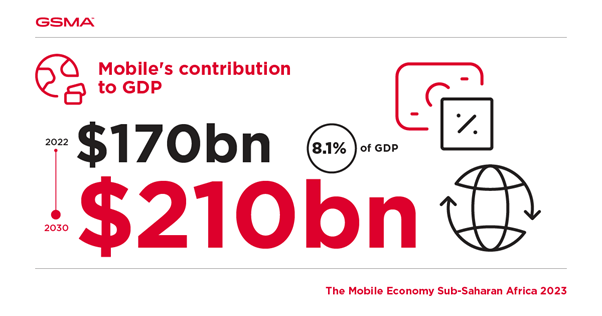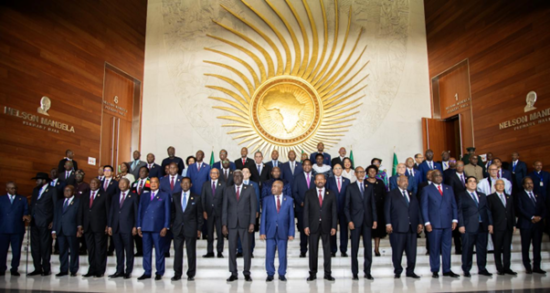
Mobile connectivity in Sub-Saharan Africa continues to drive digital transformation and socioeconomic advances@GSMA
While 3G remains the most dominant technology in the region, the adoption of 4G has accelerated, partly driven by the growing demand for faster speeds among younger consumers. Over the next five years, 4G adoption in the region will more than double to 45%.
5G momentum is also growing, although the initial focus for 5G deployment is on urban areas and industrial locations, where there is greater need for the technology. In 2030, 5G is expected to contribute $11 billion to the Sub-Saharan African economy, accounting for more than 6% of the overall economic impact of mobile.
5G is expected to contribute $11 billion to the Sub-Saharan African economy, accounting for more than 6% of the overall economic impact of mobile.

As well as growing 5G momentum, other key trends shaping the mobile ecosystem include artificial intelligence and the opportunity for it to steer growth; improving smartphone access; a move towards circular economy principles in light of growing climate concerns; and the rise of fintech which is driving collaboration and innovation across the region.
Mobile connectivity in Sub-Saharan Africa continues to drive digital transformation and socioeconomic advancements. This underlines the need for continued efforts to address the persisting barriers that impact mobile internet adoption in the region, particularly the affordability of devices, online safety concerns and the lack of digital skills. Meanwhile, authorities and enterprises see an opportunity to leverage growing 4G and 5G networks, alongside emerging technologies such as AI and IoT, to enhance productivity and efficiency in service delivery. The adoption of 4G has accelerated in recent years, partly driven by the growing demand for faster speeds among younger consumers. Over the next five years, 4G adoption in Sub-Saharan Africa will more than double to 45%. 5G momentum is also growing, although the initial focus for 5G deployment is on urban areas and industrial locations, where there is greater need for the technology.
Key trends shaping the mobile ecosystem

Growing 5G momentum
In 2022, there was a marked uptick in 5G-related activities in Sub-Saharan Africa, including 5G commercial launches in 15 countries and a growing number of spectrum allocations. This comes at a time when 3G is the most dominant technology in the region (accounting for 55% of total connections in 2022) while 4G is already dominant in other regions, implying network and customer readiness for the transition to 4G. The approach to 5G in the region will need to consider the current connectivity landscape and unique market features that could affect the rollout and adoption of the technology. 5G network ecosystem players in the region must also find ways to deliver cost-effective and efficient 5G networks, balancing investment and value creation.
Steering growth with AI
The emergence of new AI tools and use cases is accelerating the implementation of AI across various verticals and business processes. Most AI developments are occurring in advanced markets. However, the technology can be utilised in any scenario where there is sufficient data to draw insights. As a result, several industry players are already taking steps to apply AI across a variety of use cases in Sub-Saharan Africa. The potential benefit of AI in the region is significant, given that it can help offset the impact of limited resources and poor infrastructure in the delivery of many life-enhancing services, such as healthcare and education. Mobile operators in the region have employed AI at different levels, from improving network operations and customer services to achieving efficiencies and cost savings.
Climate-related risks spur circular economy principles

In the face of growing concerns about the production of electronic waste and the over-exploitation of natural resources, the notion of circularity has become a priority for policy-makers and industry players alike. Although the technical lifespan of a cell phone today is between four and seven years, the average useful life of these devices is only around three years. Governments and industry players have a role to play in motivating consumers, for example by setting up new channels and suppliers to collect, refurbish and resell phones, or by launching sustainability awareness campaigns. Some operators in sub-Saharan Africa are already taking the lead in this area, with initiatives aimed at promoting the circularity of cell phones and other digital devices.
Improving access to smartphones
The price of smartphones is a major obstacle to mobile Internet use. In recent years, the average selling price of these devices has fallen considerably in Africa, with an influx of devices priced at under $100, but this cost remains unaffordable for many consumers in the region. The challenge for manufacturers is to produce devices at prices low enough to match local income levels and enable them to gain market share. To reduce this cost barrier, operators are implementing various initiatives, including handset financing plans, staggered payment formulas and smartphones available through partnerships with manufacturers.
Collaboration and innovation in fintech is on the rise
Fintech has become increasingly prominent in Sub-Saharan Africa, driven by the need to improve regional financial and digital inclusion. The industry has seen a rise in partnerships and innovation, leading to the diversification of products on offer, particularly in the payments segments. Operators have partnered with ecosystem players to expand products and offer options such as buy now, pay later (BNPL). At the same time, the growing fintech startup industry continues to attract investors, allowing them to improve access to a variety of financial products for both individuals and small businesses, such as microlending and B2B payments.
Policies for safe and inclusive development
As cyberattacks continue to grow in scale and scope, governments face increasing pressure to protect their citizens and infrastructure and establish a framework for the mobile industry. Sub-Saharan Africa’s rapid technological evolution makes the region an attractive target for fraud and cyberattacks. Understanding, mapping and mitigating these existing and upcoming security threats in an objective, speedy and effective manner is essential. Some countries, including Eswatini, Ghana and Nigeria, already have comprehensive cybersecurity laws in place. Over the coming years, there will likely be an increased prevalence of legislative policies to promote cybersecurity related to critical infrastructure and supply chains. Meanwhile, the International Telecommunication Union’s (ITU) World Radiocommunication Conference 2023 (WRC-23) will take place from 20 November to 15 December 2023 in Dubai. Held under the auspices of the ITU, the conference is an opportunity to increase digital equality, widen harmonisation and provide a clear roadmap to address future spectrum capacity needs. The futures of low-band and midband spectrum are both on the agenda at WRC-23. For mid-bands, there is an opportunity to expand the harmonisation of 3.3–3.8 GHz, 4.80–4.99 GHz and 6 GHz at WRC-23. Because of Africa’s high percentage of rural population and vast geography, low bands form a critical part of the region’s digital future and can ensure that 5G delivers benefits for all consumers.




